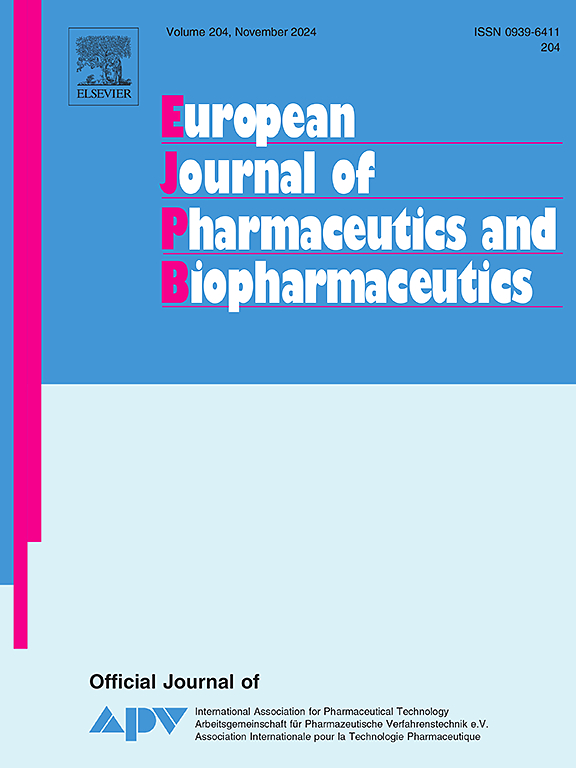Dual targeted lipid nanoparticles for enhanced DNA delivery and transfection of breast cancer cells
IF 4.4
2区 医学
Q1 PHARMACOLOGY & PHARMACY
European Journal of Pharmaceutics and Biopharmaceutics
Pub Date : 2025-02-21
DOI:10.1016/j.ejpb.2025.114674
引用次数: 0
Abstract
Lipid nanoparticles (LNPs) have gained much attention as non-viral gene delivery systems due to their large payload capacity, reduced immunogenicity, and cost-effective manufacturing. Surface modification of LNPs by covalent attachment of receptor ligands can improve their tissue specificity and reduce off-target effects. In the present work, DNA-LNPs were therefore designed to target breast cancer, particularly the invasive HER2-positive subtype. Targeting was mediated by trastuzumab (Herceptin®) a monoclonal antibody binding to the extracellular domain of the human epidermal growth factor receptor protein (HER2). To overcome intrinsic trastuzumab resistance for some patients with HER2 positive breast cancer, a dual-targeting strategy was employed by combining Herceptin with folate to enhance LNP uptake by cancer cells.
Dual-targeted LNPs encapsulating plasmid DNA, coding for a fluorescent reporter protein (tdTomato or EGFP), were prepared using folate-conjugated PEGylated lipids. Subsequently, thiolated Herceptin was conjugated to the surface of the LNPs. At an N/P ratio of 6, small and uniform targeted LNPs were obtained, with a slightly negative ζ-potential. Cellular uptake and transgene expression were characterized in vitro using three breast cancer cell lines (MCF7, MDA-mb453, SKBR3), which express varying level of the HER2 receptor. Cellular uptake correlated with HER2 expression levels and was significantly increased when Herceptin was combined with folate. In all tested breast cancer cell lines, dual-targeted LNPs led to an enhanced transgene expression compared to single-targeted LNPs. Furthermore, in vivo zebrafish xenograft studies confirmed superior targeting and transfection efficiency of Dual-LNPs under physiological conditions.
Our findings highlight the superior performance of dual-targeted LNPs to deliver a DNA expression plasmid to HER2 positive breast cancer cells, emphasizing their potential as an improved targeting and transfection strategy.

双重靶向脂质纳米颗粒增强DNA传递和转染乳腺癌细胞
脂质纳米颗粒(LNPs)作为一种非病毒基因传递系统,由于其大的有效载荷能力、较低的免疫原性和成本效益而受到广泛关注。通过受体配体共价附着对LNPs进行表面修饰,可以提高LNPs的组织特异性,减少脱靶效应。因此,在目前的工作中,DNA-LNPs被设计用于靶向乳腺癌,特别是侵袭性her2阳性亚型。靶向是由曲妥珠单抗(Herceptin®)介导的,这是一种结合人表皮生长因子受体蛋白(HER2)细胞外结构域的单克隆抗体。为了克服一些HER2阳性乳腺癌患者固有的曲妥珠单抗耐药,采用双靶向策略,将赫赛汀与叶酸联合使用,以增强LNP对癌细胞的吸收。利用叶酸偶联聚乙二醇化脂质制备了包封质粒DNA的双靶向LNPs,编码荧光报告蛋白(tdTomato或EGFP)。随后,将硫代赫赛汀偶联到LNPs表面。在N/P为6时,获得了小而均匀的目标LNPs,其ζ电位略为负。利用表达不同水平HER2受体的三种乳腺癌细胞系(MCF7, MDA-mb453, SKBR3),体外研究了细胞摄取和转基因表达。细胞摄取与HER2表达水平相关,当赫赛汀与叶酸联合使用时,细胞摄取显著增加。在所有测试的乳腺癌细胞系中,与单靶向LNPs相比,双靶向LNPs导致转基因表达增强。此外,斑马鱼体内异种移植研究证实了双lnps在生理条件下具有优越的靶向性和转染效率。我们的研究结果强调了双靶向LNPs在向HER2阳性乳腺癌细胞传递DNA表达质粒方面的优越性能,强调了它们作为一种改进的靶向和转染策略的潜力。
本文章由计算机程序翻译,如有差异,请以英文原文为准。
求助全文
约1分钟内获得全文
求助全文
来源期刊
CiteScore
8.80
自引率
4.10%
发文量
211
审稿时长
36 days
期刊介绍:
The European Journal of Pharmaceutics and Biopharmaceutics provides a medium for the publication of novel, innovative and hypothesis-driven research from the areas of Pharmaceutics and Biopharmaceutics.
Topics covered include for example:
Design and development of drug delivery systems for pharmaceuticals and biopharmaceuticals (small molecules, proteins, nucleic acids)
Aspects of manufacturing process design
Biomedical aspects of drug product design
Strategies and formulations for controlled drug transport across biological barriers
Physicochemical aspects of drug product development
Novel excipients for drug product design
Drug delivery and controlled release systems for systemic and local applications
Nanomaterials for therapeutic and diagnostic purposes
Advanced therapy medicinal products
Medical devices supporting a distinct pharmacological effect.

 求助内容:
求助内容: 应助结果提醒方式:
应助结果提醒方式:


